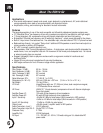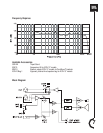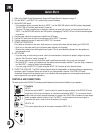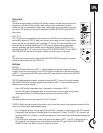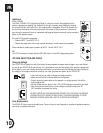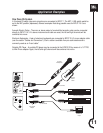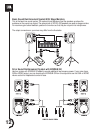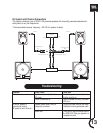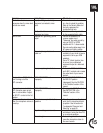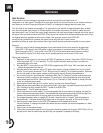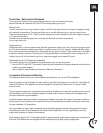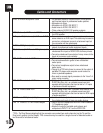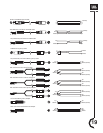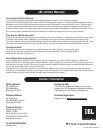
Gain Structure
Gain structure is the term we apply to adjusting the relative input sensitivity and output levels of
components in an audio system. The objective of proper gain structure is to minimize noise on one extreme and to pre-
vent clipping on the other. Proper gain structure will result in all components clipping at about the same time.
First, let’s clear up one common misconception.The input control on an amplifier or powered speaker does not deter-
mine how much power it will produce. A 100 watt amplifier (for example) can produce 100 watts no matter where the
input level control is set.The input level control simply determines how much input voltage is required to drive the amp to
full output. If the input level controls of an EON10 G2 are set too low (rotated too far counter-clockwise) the mixer will go
into clipping before the speakers are driven to full output. If the input level controls of an EON10 G2
are set too high (rotated too far clockwise) the system will be noisy. With that in mind, here’s a
procedure for setting up system gain structure that will get the best dynamic performance possible from your system.
Summary
• Adjust your mixer so that the loudest passages of your performance drive the mixer almost to its peak output.
• Set the MIC / LINE switch to the LINE position (unless a microphone is connected directly to the EON input).
Slowly bring up the INPUT 1 level control of the EON10 G2 until the desired performance volume is reached.
When used with a typical DJ or audio mixer, this will probably place the control around 10:00 o’clock.
Step by step instructions
1. Begin with all level controls on your mixer and EON10 G2 speakers at minimum. Note that the EON10 G2 has a
switch that selects “Mic” or “Line” sensitivity. The “Mic” position should be used only when a microphone is
connected directly to the input.
2. Bring the INPUT 1 level control on your EON10 G2s to approximately 9:00 o’clock. We’ll come back and make
some final adjustments here later on.
3. Bring the output of any electronic source (CD player, drum machine, electronic keyboard, etc.) to its “nominal”
position. This will usually be marked. If it isn’t, bring the control to about 2/3 of its maximum position. Make sure
that any foot pedals or other volume controls are at the position they will be during the performance.
4. At your mixer, bring the “Input Attenuator” (sometimes called “Gain” or “Sensitivity”) control up while playing the
instrument or talking / singing into the microphone. Be sure that the level you’re playing at is the same as the
actual performance level will be. Watch the channel “Clip” or “Overload” or “Peak” indicator. It should just flicker
on the very loudest dynamic peaks.
5. Now bring the channel fader up to its “nominal” position (see the mixer Owners Manual).
6. Slowly bring the mixer master faders up to their nominal position. At this point, you should hear sound from the EON10
G2s. If the level is too high, trim back the INPUT 1 control on the EON10 G2s.
7. Repeat steps 3 – 5 for all remaining channels.
8. Check the meters on the mixer output. If you’re seeing peaks that drive the meters into clipping, trim back the
channel faders and master faders slightly. Also be aware that actual performance levels tend to be higher than
rehearsal and sound check levels so you may want to trim back the input sensitivity slightly.
9. If an outboard processor such as a graphic EQ is used, it should be set to “unity gain” (see the processor’s
Owners Manual). Unity gain means that the signal level on the output is the same as the level at the input.
10. Now bring up the input control of your EON10 G2 speakers until the desired performance
volume is reached. If clipping occurs before the desired volume is reached you need more speakers or a lower
performance volume.
11. Listen to your mix and adjust to taste.
12. At this point, the maximum output of the mixing console should be capable of driving your EON10 G2s to full out
put and you will have the lowest noise operation that your equipment is capable of delivering.
16
Reference



